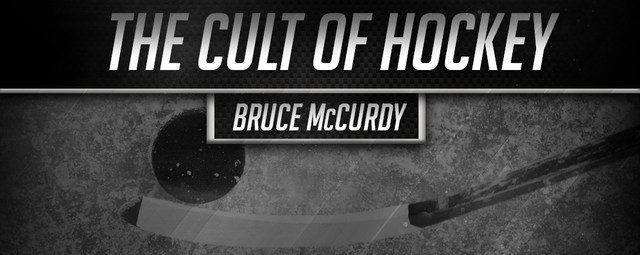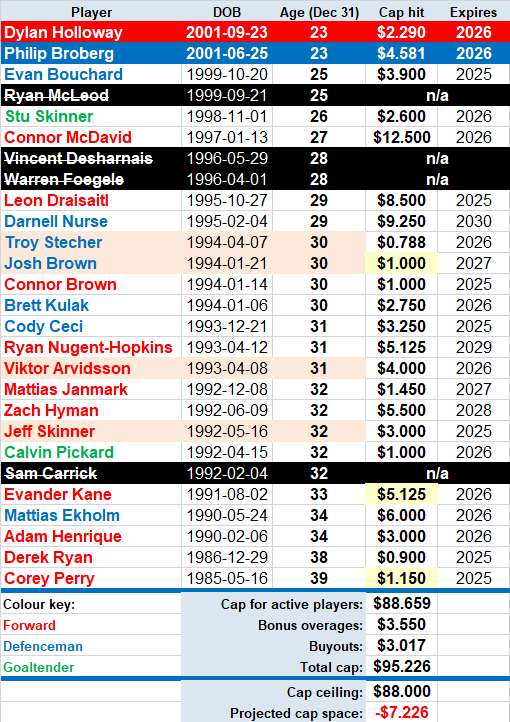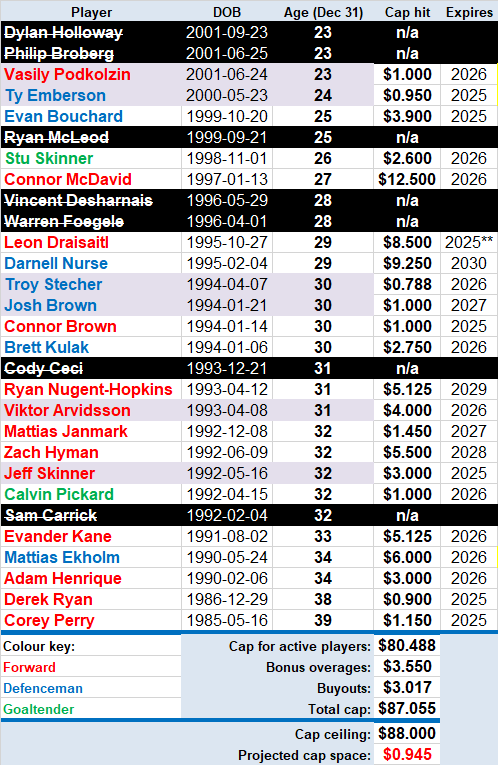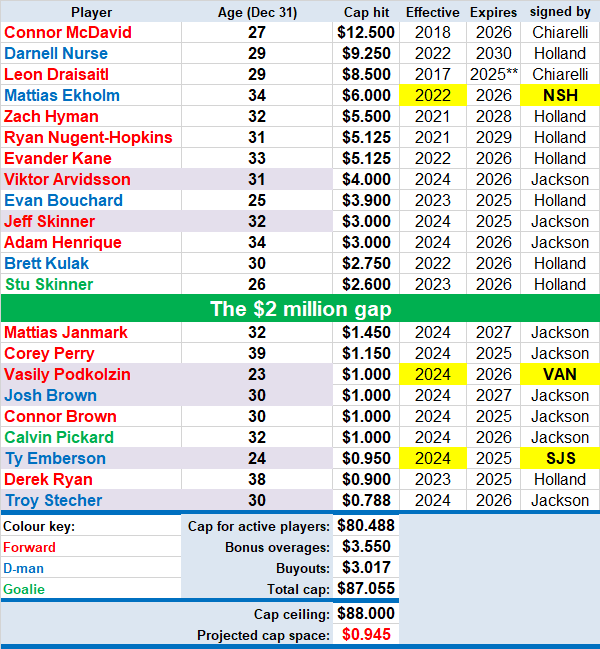A month ago when Edmonton Oilers had just been double-whammied by the St. Louis Blues’ offer sheets for Philip Broberg and Dylan Holloway, I presented this table of a projected roster reflecting summer moves to date:
The projection then was a 23-man roster, based on the 23 who dressed for the Oilers in the playoffs, minus 4 who were definitively gone, plus 4 who had been signed and projected to make the squad. The list was presented youngest to oldest, with some dire words about what might happen to Edmonton’s youth and team speed if the two youngest guys were to move on. Broberg and Holloway themselves were shown in a state of limbo, while the cap figures at bottom representing the ugly truth were the Oil to have matched the offers.
We know now; they didn’t. We also know what happened next, a pair of trades that were completed while the offer sheet clock was still ticking. Since then, the news of the Leon Draisaitl extension which, while highly significant, has no baring on the cap situation in the season to come.
So with training camp now looming, it’s time for an update:
Three additional subtractions from the earlier list, including Cody Ceci in addition to the purloined pair. In return, a pair of cost-controlled young players in the persons of Vasily Podkolzin, 23, and Ty Emberson, 24. Hey lookit! They’re now the two youngest players on the team.
Not sure that either newcomer is a skater in the class of Broberg and Holloway, never mind Ryan McLeod and Warren Foegele, subjects of the earlier purge. Looking at the entire range of changes, there’s little doubt that team speed took a hit, and the squad as a whole got a bit older.
But the very good news for Oil fans is that the salary cap is now back in a good place. Broberg, Holloway and Ceci will draw their collective $10+ million (!) from other teams in 2024-25, while their replacements (including, in this projection, an open roster spot) will draw a little under $2 million.
Those losses hurt, but the team is in a better position strictly from a cap perspective. Indeed, by this model they will be almost $1 million under the cap with no need of Long Term Injured Reserve, meaning that that margin can be accrued as the season goes along. That amount projects to taking on additional cap of around $4 million at the deadline. More, with retention.
It also would allow the club to tinker around the edges. If this were the season-opening roster, it would be wise to keep Matt Savoie on the roster for at least a day, a step that would put allowances for his $1 million in bonuses into next year country rather than being a major nuisance in the event of a recall later this season. Heck, there would be room to keep him around, but that would throw a monkey wrench into those accrual plans.
So too of course would injuries, which is another reason they’d like some breathing room in the first place. As it stands, there is room to withstand the absence of Evander Kane without need for LTIR, which is huge.
Let’s re-sort that same projected roster in order of cap hit.
In this version I’ve dug into the contracts a little deeper, showing their start and finish dates as well as the GM that signed them. Wouldn’t you know that there are more players on the roster who were signed (or re-signed to extensions) by Jeff Jackson in his scant month on the job (9) than remain on contracts signed by Ken Holland (8). The fact remains that Holland’s deals were and remain by far the more impactful; they account for a combined $35 million in the season to come, an average of $4.4 million per player. Jackson’s sum to a little over $16 million, or $1.8 per player. Then there’s Peter Chiarelli, whose 2 remaining contracts were both monsters summing to $21 million per season or $10.5 per player. Those two guys will need no introduction here.
Then there’s three cases where the Oilers took on a contract signed elsewhere, highlighted in yellow. One, Mattias Ekholm, was acquired by Holland, and stands out as the only one of the seven in the $5 million class that has no movement or trade restrictions. Then there are the two most recent additions, Podkolzin and Emberson, both of whom reached the end of their ELCs last year, just as Broberg and Holloway did. The difference in the former’s cases is that both had already signed bridge deals at a reasonable cost. The Oilers were unable to do likewise with Broberg or Holloway, so they simply replaced them with similar aged players who were already signed.
A bit risky in the sense of possible upside for the departing first-rounders, that said the incomers are not exactly devoid of skills either. Both are apt to receive similar opportunities as did the departed, at what turns out to be a fraction of the cost. Can they cover that bet? Such are the gambles in the salary cap world. Pick your spots. If, say, you want to sign a Leon Draisaitl to a $14 million deal in 2025-26, you’re gonna need cheaper players at the bottom of the roster.
As for getting guys with their extensions already in hand, that solved what has become a dicey little problem for the Oilers in recent years. Every summer they’ve had 2 or 3 seemingly deserving young players up for renewal and in position for a bridge contract, defined here as post-ELC but expiring while the club still holds RFA rights on the player. Can be a second or a third contract for a given player, but must meet those criteria.
So let’s revisit the last three summers:
2021
- The best-case scenario: Stu Skinner‘s entry level deal was up, and he signed a two-year extension at league minimum. The second of those $750,000 seasons saw him make the NHL All-Rookie Team and also sign a three-year extension at a reasonable rate that extended into his UFA years so technically not a further bridge deal. Worked out great for the Oil, at least so far.
- Kailer Yamamoto’s ELC was up. The club signed him to a one-year bridge at under $1.4 million, and he responded with a 20-goal, 40-point season.
- Outcomes: Great value on the Skinner bridge, especially that second year. Good value on the one year of Yamamoto.
2022
- Kailer Yamamoto was again due, and this time was eligible for arbitration, an option he exercised. With that threat looking the Oilers signed him to a two-year bridge at $3.1 which would leave one year of RFA rights. He ultimately survived in Edmonton for just the first of those seasons.
- A year ahead of Yamamoto on the career curve, Jesse Puljujarvi had previously signed a two-year bridge at $1.4. The Oilers signed him to a one-year extension at $3.0, which would also leave one year of RFA rights the following summer.
- Ryan McLeod had no arb rights and was the odd man out. He waited all summer while the Oilers tinkered with the roster, but the situation didn’t budge. On the first day of training camp he signed a one-year deal at the low-low price of $798,000, essentially every dollar left in the budget. He did a solid for the team… for now.
- Outcomes: Puljujarvi and 100% of his remaining cap was dealt for the rights to a player who would remain in Europe. The big move was opening cap space for the acquisition of Mattias Ekholm, but the Oil received no value for the player.
2023
- Evan Bouchard was due after exploding in the last year of his ELC. He had no arbitration rights, and the Oilers let the matter slide deep into the summer, seemingly confident no offer sheet would come. Thankfully, they proved correct. Bouchard ultimately signed to a two-year re-up at a very good price of $3.9 million. While some decried the absence of a long-term deal right there and then, when considered in and of itself, that bridge deal provided fantastic value.
- Ryan McLeod was due again having more than covered the bet on that $798,000 bargain. With arb rights looming, he became an early priority, and was signed to a two-year extension at $2.1 million per season. And just like that, he was on the watch list. The following summer the final year of that pact was dealt, though in this case for a handsome return in the person of Savoie.
- Klim Kostin, acquired in an early season trade the previous season, was four years in to his career and in line for a one- or two-year bridge at a deserved raise. The Oilers couldn’t afford it. Instead, they bundled Kostin’s rights and the one remaining year in Yamamoto’s bridge deal to Detroit for, well, nothing. Nothing but cap space. But more promising young players gone with nothing to show for it.
2024
- Now it’s Broberg and Holloway who are in line for a bridge. Neither has arb rights. The Oilers are cap-strapped as usual and play hard ball a.k.a. low ball with the two promising youngsters, both of whom were eye witnesses to McLeod’s plight two summers earlier. This time, though, an outside suitor joined the fray, offered handsome money and the Oilers decided not to match. Two more young players left the team.
Trend
Just over those three years, Oilers management had a couple of brilliant successes in the bridge deals for Skinner and Bouchard.
On the negative side, they oversaw the divestiture of the last half or so of Puljujarvi, Yamamoto, and McLeod’s bridge deals, which they had themselves signed at a combined AAV of $8 million. In the process, of course, rights to the players themselves were also lost. They also were unable to make a competitive offer to Kostin, Broberg and Holloway, each of whom signed for $2+ million elsewhere. Lack of cap space meant lack of opportunity, and not much room for young players coming out of a successful ELC.
Those departed players were Edmonton’s first round picks in 2016, 2017, 2019 and 2020, their second in 2018, and a trade hit in Kostin. In return, the promising Savoie and a motley collection of draft picks. The bets the Oilers did make, didn’t cash. The ones they didn’t, may or may not cash somewhere else. A lot of development time and resources expended in the process. And in its aftermath, what I call the $2 Million Gap on the club’s payroll. Not a single contract in the range between $1.5 – $2.5 million, the exact range where the likes of McLeod, Kostin and Holloway are today. Not to mention other players who departed under other circumstances like Nick Bjugstad and Vincent Desharnais, who also signed $2 million pacts with other teams because the Oilers simply didn’t have the cap space.
The solution this time around was Jeff Jackson’s power move of acquiring a couple of NHL-experienced guys who were already signed elsewhere at a small fraction of the cost of the outgoing players. Dump Ceci’s salary in the process, and solve those cap woes, at least in the short run. Whether the acquired players will solve them on the ice won’t be known for a while.
Recently at the Cult of Hockey
LEAVINS: Penticton Game 2: Savoie, O’Reilly raise their games; 9 Things
McCURDY: Penticton Game 1: Nathan Day keeps it close
STAPLES: Edmonton Oilers big wigs on the shelf
McCURDY: Prospect countdown wrap, with links



Follow me on X-Twitter @BruceMcCurdy


